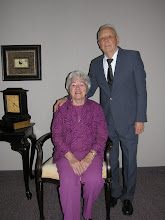 Fishing Boat at Tiberius
Fishing Boat at TiberiusWe went on a cruise on the Sea of Galilee to Capernaum, where we had lunch at a Kibbutz. Enjoyed the tasty fish, "Peter's fish," from the Sea of Galilee. It was easy to visualize Jesus walking around the waters edge teaching and healing. Here is where Simon, Andrew, James and John received their calling. The very center of Christ's Ministry ( Matt. 4: 18-25).
It was at Capernaum that Jesus healed the servant of the Centurion (Luke 7:2-10). We saw the ruins of St. Peter's house and the Mount of the Beatitudes in the distance.
Go back to October 6th for start of the Israel series.
















